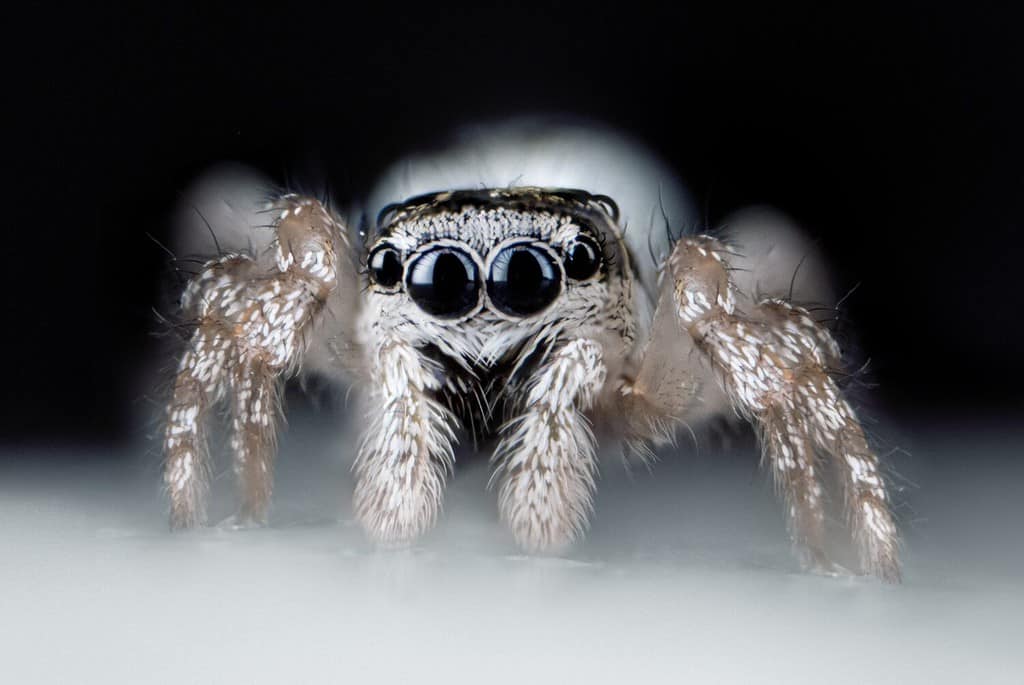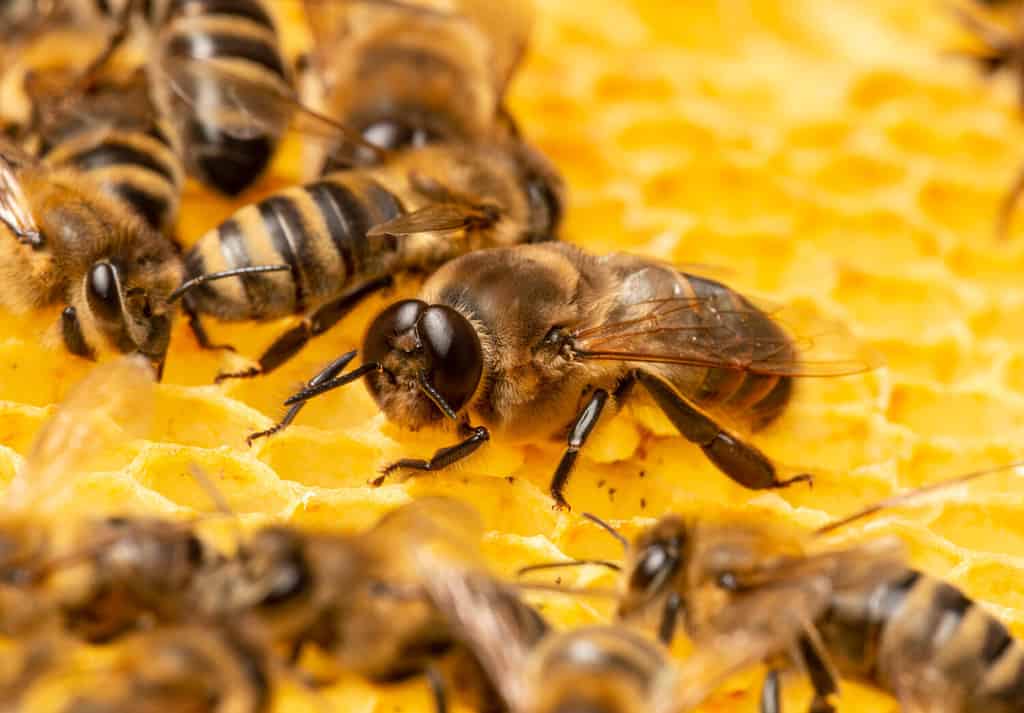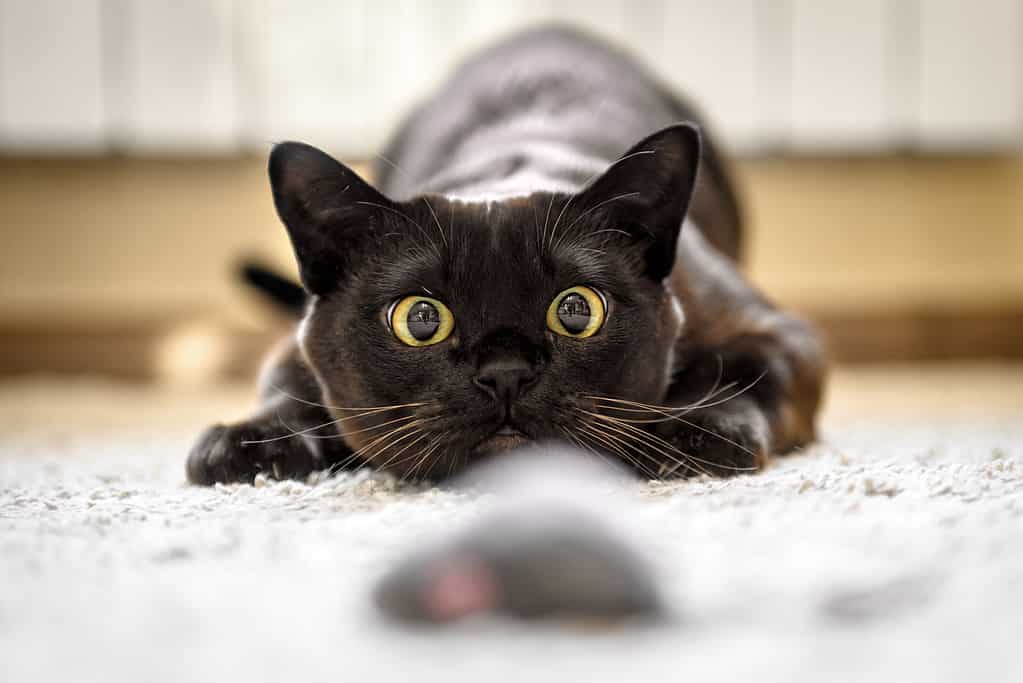Now and then, a truly odd question pops up, and you can’t help but obsess about it. Remember that doors vs. wheels debate? The whole world went a bit nuts trying to figure out which there was more of. Well, now we’ve got another head-scratcher on our hands, and this time it’s all about eyes and legs. Consider every living thing on this planet. Now, which do you think there’s a greater number of—eyes or legs? Hang tight as we tackle this question once and for all.
Are There More Eyes or Legs in the World?
No one can say with 100% certainty if there are more legs vs. eyes in the world. There are approximately 8.7 million species on Earth. About 1.2 million of these species have been identified as insects, many of which have at least six legs. As for eyes, numerous animals break the “two-eyes” rule, like chitons with hundreds of eyes and box jellyfish with 24 eyes.
Legs

Grasshoppers are born with six legs and keep the same number throughout their lives.
©juerginho/Shutterstock.com
Counting the number of legs in the world is more complicated than most people realize. It’s not as simple as counting the legs of living things or knowing how many insects exist. Why? Because our world is too complex for simple math to provide us with all of the answers. Things are always changing, and they’re not always as they appear to be. Take insects for example. A bug that has six legs one day might grow up to have hundreds.
Some insects, like grasshoppers, would be easy to count. They experience incomplete metamorphosis. When they hatch, they have six legs and look like tiny versions of adults. They keep the same 6 legs throughout their lives. But other bugs, like centipedes, are trickier. They shed their exoskeleton, adding more legs to their bodies as they grow.
Eyes

A lot of spiders have poor vision, instead of eyesight they rely on other senses like touch.
©Dmytro Khlystun/Shutterstock.com
Not all spiders see the world the same way. Despite having many eyes, a lot of spiders have poor vision. To survive they rely more on their sense of touch, allowing them to pick up on vibrations. Quality of eyesight is just one of the ways spiders differ. Other things that vary include eye placement and eye count. Some spiders have as many as 12 eyes, and others have no eyes at all.
What spiders can see well? The wolf, flower, and jumping spiders have excellent eyesight for hunting and recognizing mates. Jumping spiders have four pairs of eyes, with the largest pair providing high-resolution vision for hunting. These acrobatic spiders can see a broader spectrum of colors, including ultraviolet light, giving them an advantage in detecting details. Finally, the zebra black spider, the tiniest creature on Earth, is another species with great vision. Their eyes are insanely big compared to their tiny bodies, so they have excellent binocular vision.
Living Things With 6 or More Legs

Lobsters explore their environment with eight walking legs and two claws.
©Haland/Shutterstock.com
The number of legs an insect or animal has directly relates to their environment. For instance, most bugs have at least 6 legs to help them maintain balance over all sorts of terrain.
Here are a few examples of living creatures with multiple legs:
- Brine Shrimp: Up to 11 pairs of legs (total can vary)
- Centipedes: Up to 380 legs
- Velvet Worm: Around 30 pairs of stubby legs
- Millipedes: 300-700 legs
- Silverfish: 6 legs
- Spiders: 8 legs
- Pillbug (Roly-Poly): 14 legs
- Caterpillar: 16 legs
- Woodlice: 14 legs
- Lobster: 8 walking legs, 2 claws
When baby millipedes hatch from eggs, they sometimes don’t have any legs or just have four pairs of legs. As they grow, they keep adding more body segments and legs throughout their lives. Take for instance, the 1-inch long white millipede in North California, also known as the “two-stripe millipede”. They grow up to have up to 750 legs, and females have more legs than males.
Having 700 legs is pretty impressive, but that number is small compared to a new find. A recently discovered millipede has 1,306 legs, making it the first true millipede. The name millipede is derived from the Latin words “mille,” meaning thousand, and “pes,” meaning foot. However, despite their name, there hasn’t been any record of millipedes with 1,000 legs—until now.
Why Insects Need So Many Legs

Bees have six legs that they use for grabbing, collecting, and tasting.
©Kuttelvaserova Stuchelova/Shutterstock.com
Insects have more than two legs to help them accomplish tough tasks, and navigate diverse terrain. But their limbs are for more than moving things or running around. Their many legs serve a lot of intriguing purposes. Some you’ve probably never thought of before, like helping them listen.
Here are a few of the amazing ways insects use their legs:
- Pollen Collection: Female bees gather pollen with specially adapted hind legs to transport back to the nest.
- Tasting: Some insects, like butterflies and bees, possess taste buds on their front feet.
- Hearing: Certain insects pick up sound vibrations through subgenual organs in their legs.
- Grooming and Cleaning: Grooming is crucial for insects. That’s why many, like ants, have adaptations on feet for antennae cleaning.
- Grabbing: Bees use legs for grabbing flower anthers to release pollen and defend colonies from pests.
- Building: Insect legs can aid in constructing nest cells, applying linings, or building from wax.
- Gathering: Some bee species, like wool carder bees, use their legs to gather materials for nesting.
Like a lot of insects, bees have six legs. They use these legs every day to stay busy and clean. Their legs are broken up into three pairs; forelegs, middle legs, and hind legs. Each leg pair has special adaptations to serve a specific purpose. The hind legs help female bees collect and transport pollen. The middle legs are perfect for running around. And the front legs are groom antennas or grab things.
Animals With More Than 2 Eyes
As much as we rely on our eyes every day, animals depend on our eyes even more. Extra eyes often assist animals in regulating internal temperature and navigating using the sun.
Here are some of the animals that need more than two eyes to survive:
- Monarch Butterfly: Up to 12,000 eyes
- Spider: usually 8 but can be up to 12 eyes
- Horseshoe Crab: 10 eyes
- Praying Mantis: 5 eyes
- Chiton: Up to 1000 eyes
- Bee: 5 eyes
- Starfish: Varies, typically 5, but more in some species
- Scorpion: 12 eyes
- Box Jellyfish: 24 eyes
- Scallop: Up to 200 eyes
- Giant Clam: 700 eyes
What about the four-eyed fish? Anableps, also known as four-eyed fish, is a fish species found in freshwater and brackish waters in northern South America and Trinidad. Yet, despite its name, this fish only has two eyes. The eyes look like four because of a horizontal band of tissue that divides each eye into two lobes. Each eye lobe has its pupil and separate vision, so they can see both in and out of water at the same time.
Fascinating Ways Animals Use Their Multiple Eyes

Some insects, like butterflies and bees, possess taste buds on their front feet.
©David Havel/Shutterstock.com
How do animals use their multiple eyes? In all sorts of ways. Some animals use their eyes to detect light, while others focus on movement. And some can see things that are impossible for our eyes to detect. For instance, butterflies have four special parts for seeing colors, allowing them to see colors invisible to us like ultraviolet. They use their many eyes to watch the sun, navigate, and find flowers.
Chitons Have Hundreds of Eyes
There’s a sea creature with eyes made of rocks, it’s called a chiton, and it’s about the size of a tortilla chip. They’re mostly opaque, but their eyes are transparent. They can have hundreds of small eyes called ocelli all over their shells. The exact number changes depending on the species and the chiton’s life.
Aragonite is the mineral that makes up the shell, and eyes or ocelli. Each of these ocelli contains a layer of pigment, a retina, and a lens, allowing them to detect light and movement in their environment. Their eyes are also specially adapted to survive both underwater and in the air, which is perfect for their favorite hangout spots. Most chitons prefer the rocky intertidal zone, where the sea meets the land. This marine armadillo lives a sedentary life, spending its day eating algae and sponges.
Iguanas and Their Third Eye
Iguanas have a third eye. Their third eye also called the parietal eye, looks like a pale scale. It can sense movement and light, helping them quickly spot predators. Another reptile, the tuatara, has a third eye they use for regulating body temperature. While komodo dragons use their third eye to tell time. Their parietal eye feels changes in light and temperature, so they always know if it’s morning, afternoon, or evening. There was also an ancient monitor lizard that’s now extinct is believed to have had a similar 4th eye.
Dinner Plate Sized Eyes
Finally, colossal squids belong on the list of intriguing eye setups because of the size of their eyes. This sea creature only has two eyeballs, but that’s all they need. A colossal squid’s eyes are as big as dinner plates, measuring over 10 inches in diameter. They’re the largest eyes among living creatures
Seeing the World: Humans vs. Animals

Cats have better night vision compared to humans, but they don’t see as well during the day.
©scaliger/iStock via Getty Images
Human vs. cat; who has the better vision? It depends on the time. During the night, cats excel with superior night vision. But as daylight rolls around, our eyes are better adapted for high-light environments. Part of this has to do with the way our eyes are designed.
Human vision involves the cornea, pupil, iris, lens, retina, and photoreceptors, which convert light into electrical signals sent to the brain. Many animals have different setups. For instance, humans see color using three color-detecting cones. Animal color perception, works similarly, however, they don’t always have three cones. This small difference changes how they see things in a big way. For instance, dogs, with only two cone types, have limited color perception.
Many animals can see in ways we can only dream of. Nocturnal animals like geckos have superior night vision, while giant clams possess multiple pinhole eyes sensitive to the slightest movement. And some creatures, like dragonflies, have thousands of lenses in their compound eyes, granting wide vision.
Ever wish you could change your eye color? The Arctic reindeer can. Their eye color changes to help them survive different lighting throughout the year. During summer, the back of a reindeer’s eye has a shiny gold layer mixed with turquoise. But in winter, this shiny eye layer becomes a dark blue. They’re the only mammal we know about that seasonally adapts their vision.
What Do You Think?

©Ezume Images and Javier Brosch/Shutterstock.com
What do you think? Are there more legs or eyes in the world? The ongoing debate leaves us with a bit of a puzzle.
There are plenty of undiscovered species out there. Without knowing the exact number of every living thing in the world, it’s impossible to answer with certainty. And even having a number wouldn’t solve the puzzle. You also would have to know what stage of life everything was in, beyond just living or dead.
Everything’s always changing. Certain animals change as they mature. Some insects, like grasshoppers, have the same six legs their entire lives. Others, like centipedes, grow more legs as they get bigger.
The more we search for an answer to the question of legs vs. eyes, the more unclear things get. One thing we can say with certainty is that the legs and eyes of this world are amazing. From bipedal humans to thousand-legged insects, our world is full of well-designed limbs and the eyes to see them.
The photo featured at the top of this post is © Ezume Images and Javier Brosch/Shutterstock.com
Thank you for reading! Have some feedback for us? Contact the AZ Animals editorial team.






